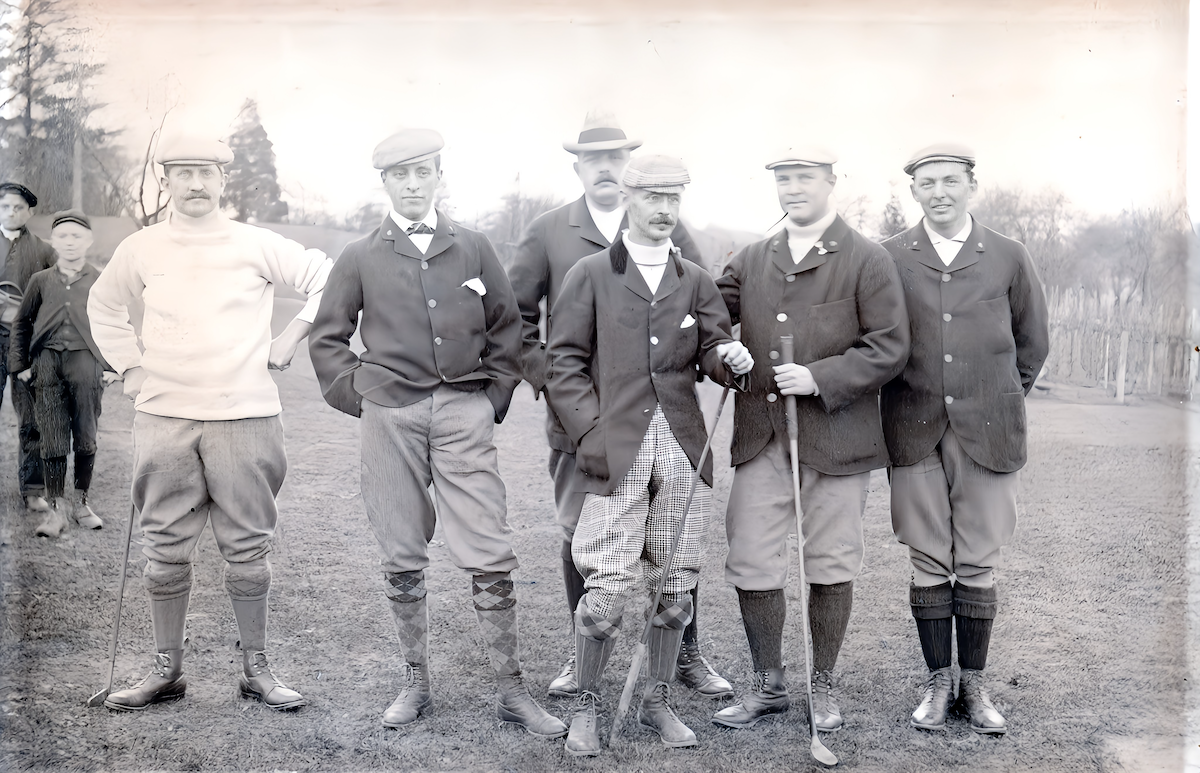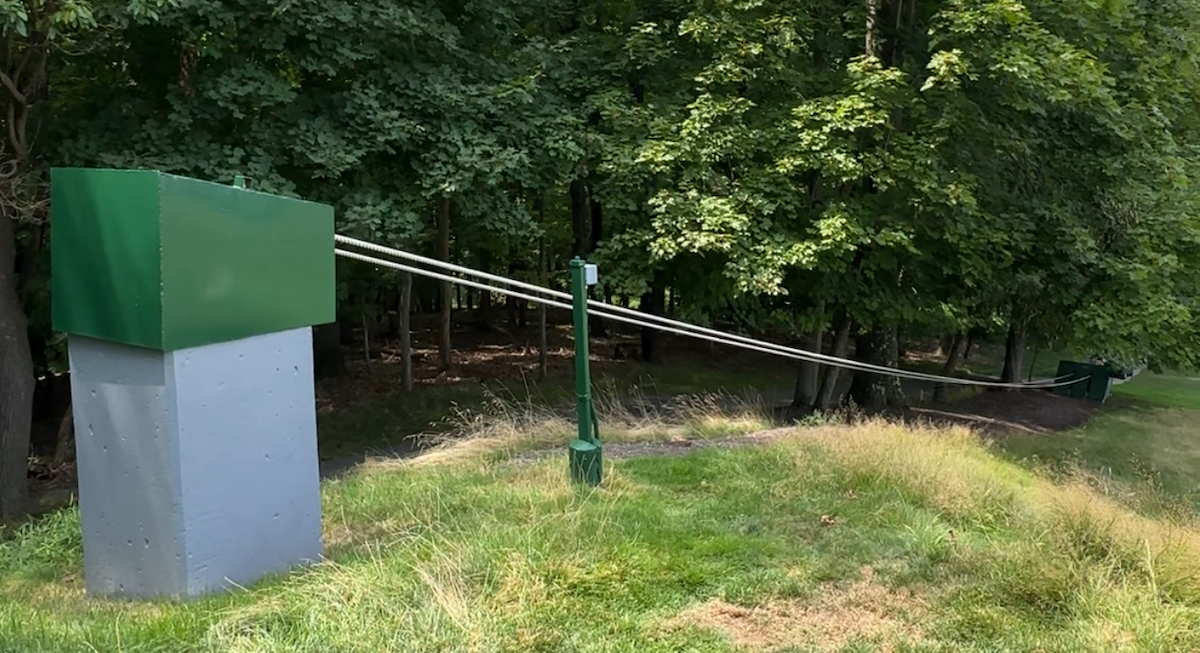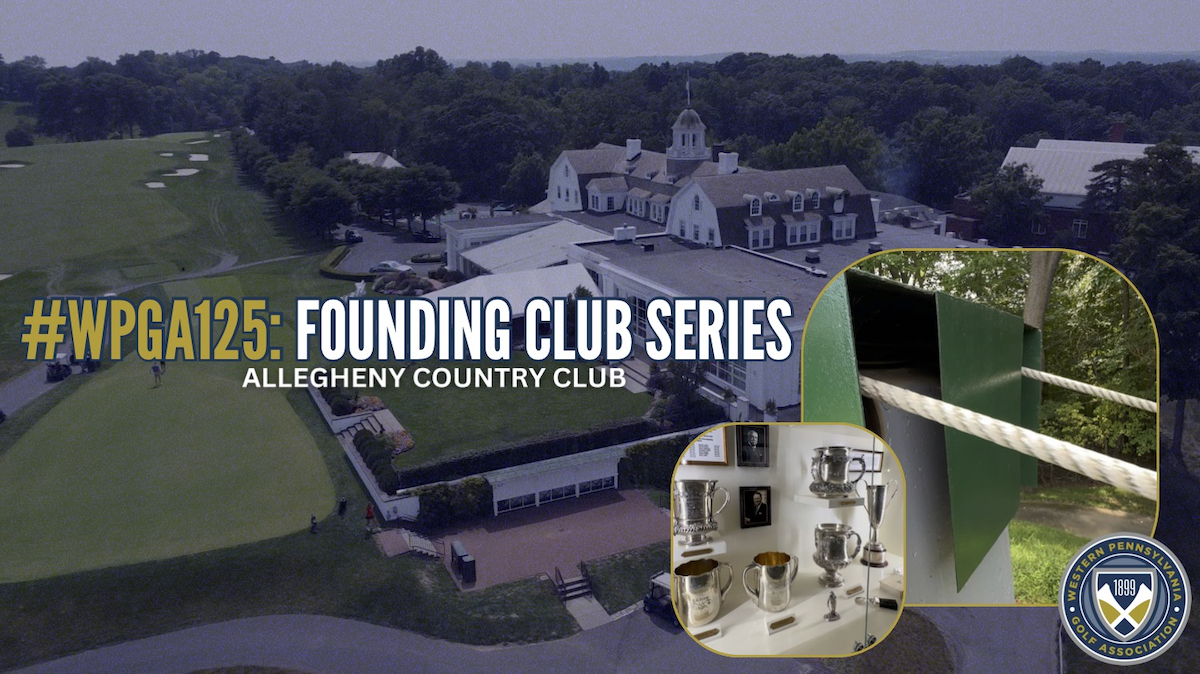WPGA Founding Club Series: Allegheny Country Club
By Josh Rowntree, Director of Communications • April 16, 2024
With a deep appreciation for the history of the game in Western Pennsylvania, Allegheny Country Club has been a pillar in the golf community for 130 years.
One of the five founding clubs of the WPGA, Allegheny’s roots are deeply interlocked with the Association’s, as well as the proud lineage of talented golfers and other exceptional courses in the region.
In 1894, John Moorehead Jr. — a steel magnate — brought the game of golf to Pittsburgh when he buried six pea cans in the infield of the old Homewood Race Tack. The following year, chasing his passion, he founded Allegheny Country Club.
Just four years later and Allegheny joined up with Edgewood Country Club, Pittsburgh Field Club, Edgeworth Club and Pittsburgh Golf Club to start the Western Pennsylvania Golf Association.
Moorehead Jr. served as the WPGA’s president for the first 13 years of its existence.

1896 ACC Golf Team: The original Allegheny Country Club golf team, circa 1896, that played interclub matches with Cincinnati Golf Club. From left to right: William Patton, William C. Robinson, William Blakely, Bernard S. Horne, John Moorehead Jr., and William N. Murray. Photo courtesy of Allgheny Country Club.
Meanwhile, Allegheny — first situated in what is now Pittsburgh’s North Side between Brighton Road and California Avenue — needed to expand during that time. It moved out of the city, finding land in Sewickley.
Beginning in 1913, legendary golf course architect Donald Ross transformed the Tom Bendelow designed initial course into what it is today, doing so over the next 35 years — an unusual amount of time for Ross to commit to one club. But the results made the time well spent.
“It’s a great course for a lifetime,” says Mark Larson, Allegheny Country Club’s historian. “It’s a course that can treat you unkindly at times, but it doesn’t beat you up on a daily basis. You can age well into this course.”
Allegheny acquired more and more land over the years, changing the footprint of the course and establishing itself as one of the most treasured layouts in Western Pennsylvania.
The Club brought in top players to compete and practice, such as Harry Vardon, Bobby Jones, Chick Evans, Willie Anderson, John McDermott, Glenna Collett and Mickey Wright.
“We had big names, who had big significance at the time, show up for matches,” says Larson. “All of that added to the aura of the club. It’s much broader than golf, but golf has always been at the center.”
Allegheny also hosted premier national competitions in the 1954 U.S. Women’s Amateur, the 1990 U.S. Women’s Mid-Amateur and the 2001 U.S. Senior Women’s Amateur — which began the morning of the September 11, 2001 terrorist attacks and finished two days later.
The top-end women’s competitions have been just a fraction of the club’s commitment to women’s golf in the region.
The club’s most famous female player is, undoubtedly, amateur golf legend and Western Pennsylvania Golf Hall of Famer Carol Semple-Thompson, the winner of seven USGA national titles whose father was a former USGA President. But Semple-Thompson is far from alone.
“It goes back even further, back to the beginning,” says Larson of the premier women’s golfers to grace Allegheny. “Even as early as 1902, women could join the club on their own. There was a special category for membership for ladies who were unmarried or widowed. We had strong women’s players going way back.”
And they still do today, with several of the top female golfers to come out of Western Pennsylvania in recent years having been trained at Allegheny.
Another recognizable figure in Allegheny Country Club’s history is Eben M. Byers, who won the 1906 U.S. Amateur. Regionally, Byers won six West Penn Amateurs and two West Penn Open titles.
But Allegheny’s importance, as Larson says, does resonate beyond the game of golf.
Allegheny has deep roots in tennis, being one of the few private clubs to host the Davis Cup. On-site today, it has one of the best tennis training centers in the area, with an upgraded facility in the works.
It had a strong equestrian program, and has hosted horse and dog shows that would regularly bring in over 2,000 spectators — some of which willingly walked two miles to be a part of the festivities.
“The most important word in our name is ‘club,’” says Larson. “We are not just an expensive tee time. We have a history, a legacy and a pride in what this club is, how we feel about our fellow members, and what this club has meant to this region.”
But golf is certainly at the forefront of Allegheny’s pride. The course is consistently immaculate, and it has some unique features such as a mechanical tow rope that aids players in walking up the sharp hillside between the 3rd green and 4th tee.

Tow rope that helps move players from the 3rd green to the 4th teeing area.
When finishing a round at Allegheny, golfers walk a fairway that membership facetiously claims was ‘attacked’ by the U.S. Navy in 1954. A naval pilot made an emergency landing on the 18th hole, destroying his plane.
Lt. John Pini, who manned the aircraft, suffered only a broken leg in the crash.
He joked, “I don’t know how anyone could golf on this course when I can’t even land a plane on it.”
Stories like that seem endless at Allegheny, with much of it being crafted by the bond of the membership – a bond that stretches back to the days in the Allegheny West neighborhood, when the original members all lived within a couple of streets of one another.
In the early days, those decided to wager on how many strokes it would take to reach the front steps of the Pittsburgh club from Sewickley. And so, early one morning, they figured it out, hitting shot after shot — some banking off street cars, others nearly causing fights due to their waywardness, and some whizzing past their homes in Allegheny West — until the ball finally reached its destination miles away from the Sewickley clubhouse.
Today, Allegheny serves as a reminder of the gilded age of golf and culture, while also providing modern amenities in its breathtaking clubhouse and on its grounds. The blend of old and new keeps membership thriving and engaged.
Larson, along with golf historian Dave Moore, have turned the lower level of the clubhouse into a walking museum dedicated to the history of golf at Allegheny Country Club and in Western Pennsylvania. It features one of the most extensive trophy and medal collections of any club in America.
Their work has helped preserve the stories. While they are seemingly limitless, they are only so because of the new ones being created, cherished and chronicled today.
“The history is really important to us,” says Larson. “It starts at the beginning. We started documenting our history from very early on. That’s why we know so many of these great stories.
“There isn’t a member that shouldn’t feel proud of Allegheny Country Club. We were the pioneers of the game in this city, and we are now one of the leaders in preserving the game’s history in our region.”
Golf historian Dave Moore and Mark Larson helped contribute to this story.
For media inquiries, please contact WPGA Director of Communications Josh Rowntree.
About the WPGA
Founded in 1899, the Western Pennsylvania Golf Association is the steward of amateur golf in the region. Started by five Member Clubs, the association now has nearly 200 Member Clubs and nearly 37,000 members. The WPGA conducts 14 individual competitions and 10 team events, and administers the WPGA Scholarship Fund and Western Pennsylvania Golf Hall of Fame.
